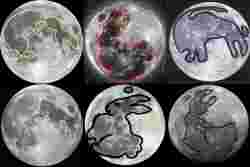Contents
Origin of the Rorschach test cards

You may have played this game when you were young: a few drops of colored ink crushed in a sheet folded in half in the middle, and you got pretty butterflies, or birds... your imagination was on.
This process, klecksography, was first explored by Justinus Kerner in 1857, who included it in his collections of poems. The recognition of patterns in random elements is called apophenia.

This phenomenon has been studied by various psychiatrists, including the famous Hermann Rorschach. As a psychiatrist, he studied human perception, and ended up realizing that some responses contained constants in front of this kind of ink stains, in cases of schizophrenia in particular. He then designed a set of ten cards, carefully chosen for the interesting answers they provided.

From ink stains to photomanipulation
Fortuitously, I noticed that by copying a photo on itself in Photoshop, after having turned it over, the transparency associated with layer effects rendered other shapes by symmetry . I immediately thought about the Rorschach cards and inkblots.
After a few tries, I developed a process that produced results that were magnificent, strange, sometimes worrying, sometimes hilarious. But why ?
Some explanations

Why do we tend to see things in spots or mirrored shapes? After some research, we can discover amazing things: the Virgin Mary on a slice of toast, or rabbits in the Moon...
The mathematician Richard Taylor recently discovered with a team of researchers from Oregon that pattern perception is linked to the complexity of fractal patterns of the edges of the drawing, these repetitive figures found everywhere in nature. The more fractals there are in a drawing, the more the number of perceived images is limited. This also means that the less the tasks are delimited and complex, the more the interpretation that is made of them is free and multiple.

Add to this that the human mind is accustomed to looking for known patterns in an image: as soon as something more or less resembles eyes, the person looking reconstructs shapes around this recognizable pattern. Is it an atavism that allows you to spot predators or preys from afar? Nature almost always produces creatures or plants with an axis of symmetry...
Discover the strange Rorschach series by 
With many other tests, I realized that the photos of artistic nudes are perfectly suited to the task: faces, hair, limbs tend to combine in unexpected and very aesthetic way.
I then created a whole series of Rorschach-themed photomontages which you can enjoy in the Photomontage section, almost all based on my nude photos. Yes, yes, take a good look: here hands protruding, there the globe of a breast, over there a pair of legs and elsewhere a truncated face.
Here’s how you can conciliate inkblots, psychiatry and photography!
You might also be interested in this...
 Who is AbsurdePhoton ?
Who is AbsurdePhoton ?


 The Rorschach effect: Technophile (Photomontages)
The Rorschach effect: Technophile (Photomontages)
Actually I think Art lies in both directions - the broad strokes, big picture but on the other hand the minute examination of the apparently mundane. Seeing the whole world in a grain of sand, that kind of thing.
Peter Hammill







